The Ultimate Guide to Choosing the Best Interior Paint Color for Selling a House: Expert Tips to Maximize Your Home’s Appeal
Dull, lifeless walls can instantly turn potential buyers away from an otherwise perfect home. Many homeowners struggle to select paint colors that appeal to buyers, potentially leaving thousands of dollars on the table. The wrong color choice can make rooms feel cramped, dated, or uninviting, deterring serious offers. Smart paint color selection helps homes sell faster and command higher prices in today’s competitive market.
The best interior paint colors for selling a house are neutral shades like soft grays, beiges, and crisp whites. These versatile colors create bright, welcoming spaces that appeal to the widest range of potential buyers. Professional painters and real estate agents consistently recommend these hues because they help buyers envision themselves living in the space.
In this guide, we’ll explore everything you need to know about choosing paint colors to maximize resale value.
Key Takeaways
- Opt for neutral, light colors like whites, soft grays, and beiges to create broad appeal and make spaces appear larger and cleaner.
- Use eggshell or satin finishes for durability and easy maintenance in high-traffic or moisture-prone areas.
- Avoid bold, dark, or polarizing colors that can deter buyers and make rooms seem smaller or outdated.
- Properly prepare walls before painting, including cleaning, sanding, and taping, to ensure a professional, polished look.
- Complete painting 2-3 months before listing to maximize visual appeal and allow for any touch-ups or drying time.
Why Does Paint Color Matter When Selling a House?
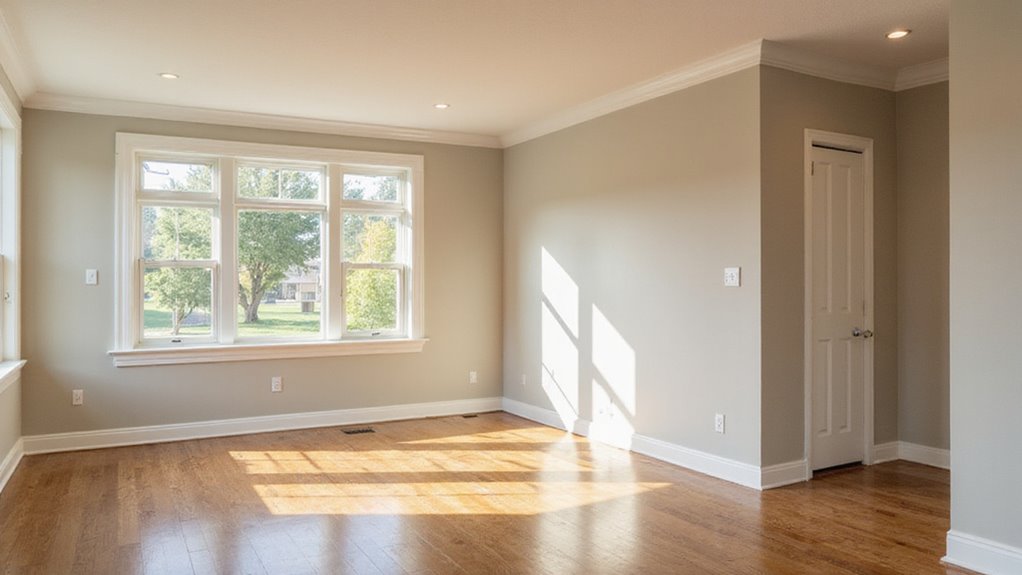
Paint colors directly impact a home’s sale price and time on the market. Light neutral colors can increase a home’s value by $10,000 to $15,000. The right paint shades create an immediate emotional connection with potential buyers.
Additionally, neutral paint colors make spaces appear larger and more inviting. Buyers can better visualize their furniture and decor in a neutral setting. Clean, fresh paint indicates good maintenance and reduces buyer concerns about immediate updates.
Moreover, paint offers the highest return on investment for pre-sale improvements. A $200-500 paint investment typically yields a 150-400% return through faster sales and higher offers.
What Are the Best Interior Paint Colors for Home Sales?
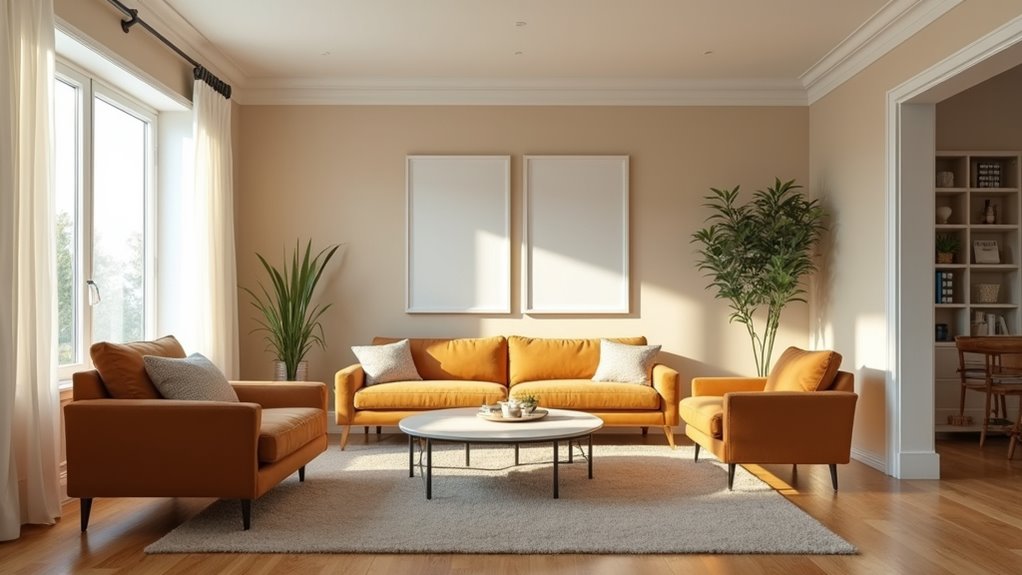
Choosing the right interior paint colors can boost your home’s appeal and sale price. Neutral shades like whites, light grays, and soft greens create a welcoming, versatile look that attracts buyers. Incorporating accent walls with modern charcoals adds style without overwhelming small spaces.
Neutral White and Off-White Shades
Neutral white and off-white paint shades create bright, welcoming spaces that most buyers prefer. These classic colors make rooms appear larger and more open. A clean white backdrop allows potential buyers to visualize their own design style.
To maximize appeal, select warm beige undertones for added comfort and versatility. Eggshell or satin finishes offer the best balance of durability and visual appeal. Furthermore, neutral walls complement any furniture or decor choices.
Above all, white and off-white colors deliver reliable resale value through their broad market acceptance and timeless appeal.
Light Grays and Greiges
Light grays and greiges offer sophisticated alternatives to traditional white walls. These colors create warm, welcoming spaces that most homebuyers desire. A greige palette combines gray and beige tones to deliver timeless appeal.
For best results, these neutral shades work exceptionally well in main living areas and bedrooms. An eggshell or satin finish provides optimal coverage and visual appeal. Moreover, the versatile nature of these colors coordinates seamlessly with various decor styles.
Consider light grays and greiges to enhance your home’s marketability. These modern neutrals help spaces appear larger while maintaining a cozy atmosphere. As a result, your home can attract more potential buyers.
Soft Blues and Greens
Soft blues and greens create the most soothing and marketable interior paint colors. These gentle hues promote relaxation and well-being in any room. Natural tones help buyers feel instantly comfortable when touring a home. The colors blend seamlessly with most furniture and decor styles.
Beyond aesthetics, soft blues can lower blood pressure by up to 15% according to color psychology research.
A fresh green palette brings the outdoors inside while maintaining broad appeal. The combination works especially well in bedrooms, living spaces, and kitchens.
Warm Beiges and Taupes
Warm beiges and taupes create inviting spaces that help sell homes faster. These neutral colors appeal to most buyers through their versatility and timeless quality. The warm undertones make rooms feel cozy and welcoming.
As a practical choice, beige and taupe work with 90% of furniture styles and color schemes. The right finish enhances these colors’ appeal. An eggshell or satin finish offers the best durability for high-traffic areas.
For best results, select shades with subtle yellow or pink undertones. Modern buyers respond well to these classic neutrals. The colors provide an excellent backdrop for staging and showings.
Modern Charcoals for Accent Walls
Modern charcoals create stunning accent walls that enhance interior design. These deep gray shades work especially well in contemporary homes. A single charcoal wall can increase perceived room depth by up to 30%.
Strategic placement matters for the best visual impact. The ideal locations include living room feature walls and primary bedroom headboard walls. Natural light should fall across the charcoal surface to highlight its rich undertones.
Moreover, charcoal walls pair beautifully with light neutrals and metallic accents. The recommended paint finish is matte or eggshell for optimal results. Your space will feel more sophisticated and intentionally designed with this timeless color choice.
Which Rooms Should You Prioritize for Repainting?
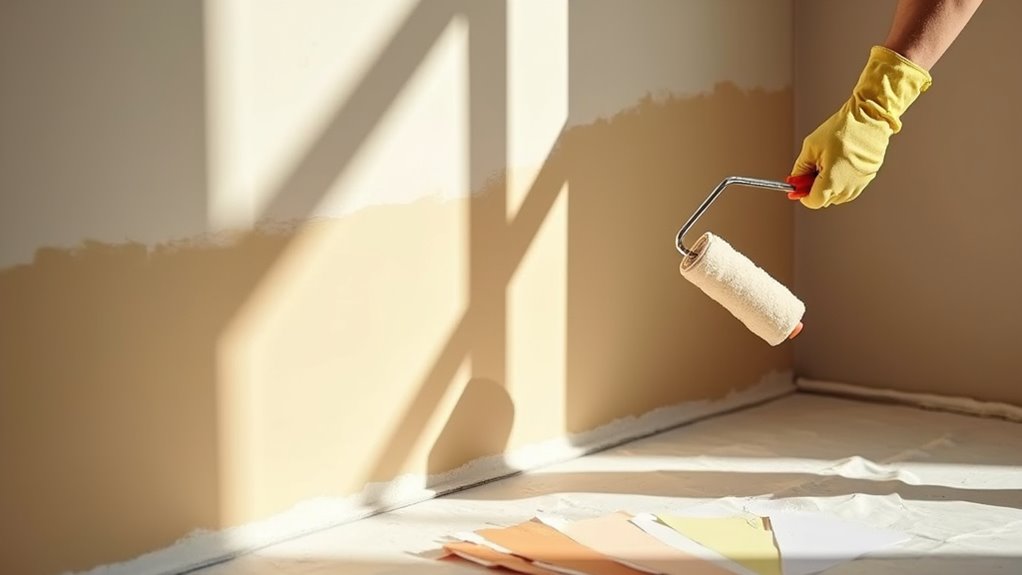
Focus on repainting the living room and entryway first, as these high-traffic areas create a powerful first impression. The kitchen should also be a priority, since color choices here can influence buyer perception and value.
Don’t forget to update the master bedroom and bathrooms with neutral, appealing colors to maximize appeal and potential ROI.
Living Room and Entryway Impact
Living rooms and entryways create lasting first impressions for visitors and potential buyers. A fresh coat of paint in these spaces can increase home value by up to 5%. Light, neutral colors like soft grays and warm taupes work best for broad appeal.
To maximize impact, use eggshell or satin finishes that balance durability with visual appeal. Proper paint selection helps buyers envision themselves in the space more easily. The right color choices also make rooms appear larger and more inviting.
Kitchen Color Considerations
Light neutral colors deliver the highest resale value in kitchens. Soft beige, warm taupe, and light gray appeal to 85% of potential buyers. These shades make spaces feel clean and welcoming to visitors.
Natural color choices help rooms appear larger and brighter to prospective buyers. Paint manufacturers recommend staying within a neutral palette of 3-4 complementary shades. Fresh whites and cream tones work particularly well in smaller kitchens.
Beyond that, gentle earth tones create a comfortable atmosphere that connects with buyers emotionally. Market data shows neutral kitchens sell homes 40% faster than those with bold color choices.
Master Bedroom Paint Strategies
Master bedroom paint colors deliver the highest return on investment for home staging. Neutral and muted tones create a peaceful atmosphere that appeals to most buyers. The best colors include warm beige, soft gray, and subtle blue tones with an eggshell or satin finish.
Paint selection directly impacts buyer emotions and perceived room value. A freshly painted master bedroom in calming colors helps potential buyers envision themselves in the space.
The color table provides specific guidance for coordinating your entire home’s paint scheme. Strategic paint choices in the master bedroom can increase overall home appeal and potentially boost sale prices.
Bathroom Color Recommendations
Best bathroom colors include soft gray, warm beige, light blue, and crisp white. These neutral shades create a peaceful, spa-like atmosphere in any bathroom space. Paint should have an eggshell or satin finish for moisture resistance and easy cleaning.
Natural tones help make small bathrooms appear larger while maintaining a timeless appeal. Light colors reflect more light and enhance the feeling of cleanliness. For a cohesive look, these shades complement most fixture finishes and tile choices.
Moreover, neutral bathroom colors increase home resale value by appealing to most buyers’ preferences. Simple color schemes allow accessories and decor to take center stage.
How to Choose the Right Paint Finish for Each Room?
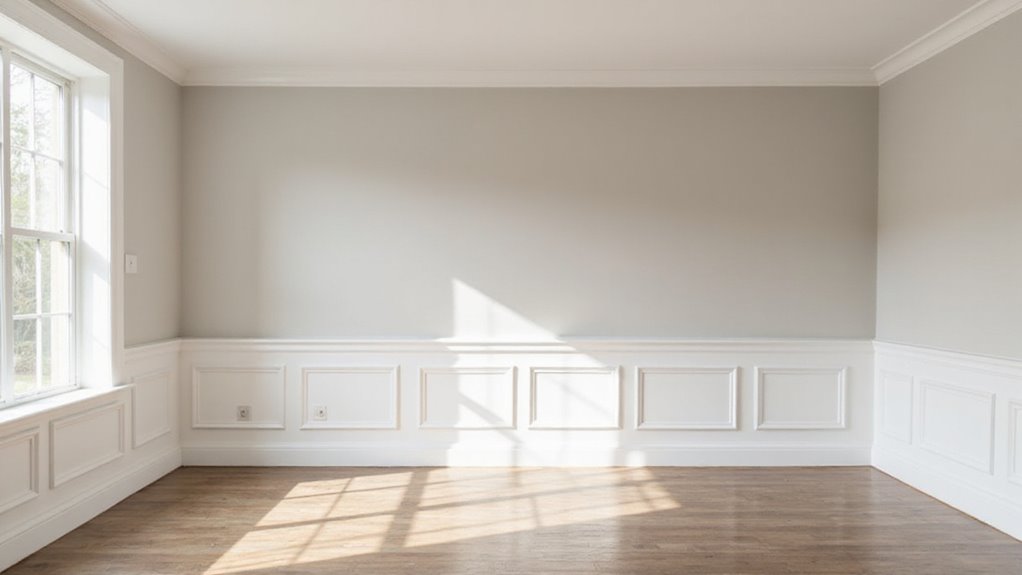
Choosing the right paint finish depends on each room’s function and your goals for durability and appearance.
Flat and matte finishes hide imperfections but aren’t ideal for high-traffic areas, while eggshell and satin offer a good balance of sheen and durability.
For kitchens, bathrooms, and trim, semi-gloss or gloss finishes provide a washable surface that stands up to moisture and cleaning.
Flat and Matte Finishes
Flat and matte paints provide non-reflective, smooth wall surfaces that hide surface flaws. These finishes absorb light instead of reflecting it, creating a soft, sophisticated look in any space.
These paints work best in low-traffic areas like bedrooms and formal living rooms. The finishes can’t withstand heavy scrubbing or moisture exposure. To maintain their appearance, gentle cleaning with a soft cloth is recommended.
Moreover, flat and matte finishes excel at concealing wall repairs and drywall seams. These subtle finishes complement both modern and traditional decor styles. For optimal results, pair flat finishes with semi-gloss trim to create visual interest.
Eggshell and Satin Options
Eggshell and satin finishes provide excellent durability and appearance for interior walls. Both options balance practicality with visual appeal for modern homes.
Satin works best in high-traffic spaces like living rooms, entryways, and bathrooms due to its moisture resistance and easy-clean surface. A satin finish reflects roughly 35% more light than eggshell, making rooms appear brighter.
Eggshell proves ideal for bedrooms and kitchens, hiding wall imperfections while offering a softer, more subtle sheen. This finish requires less maintenance and shows fewer touch-up marks over time.
In fact, both finishes last 5-7 years with proper care and resist daily wear better than flat or matte options.
Semi-Gloss and Gloss Applications
Semi-gloss and gloss paints work best in specific areas of the home. Semi-gloss finishes belong on doors, trim, cabinets, and high-traffic walls that need frequent cleaning.
Gloss finishes suit accent walls and architectural features where a high shine is desired. Furthermore, these finishes excel in rooms with moisture exposure like kitchens and bathrooms.
The reflective surface brightens spaces and resists water damage effectively. Proper surface preparation remains crucial since glossy finishes reveal wall imperfections. As a practical choice, these durable finishes protect walls while adding visual interest to any room.
Durability Factors to Consider
Key durability factors include foot traffic, moisture exposure, cleaning frequency, and surface wear. High-traffic rooms need durable paint finishes like satin or semi-gloss that withstand regular cleaning.
Kitchens and bathrooms require moisture-resistant finishes to prevent damage from water and steam. Environmental conditions also affect paint longevity.
Direct sunlight can fade paint colors over time. Temperature changes may cause paint to crack or peel. Professional-grade paints offer better protection against these challenges.
What Colors Should You Avoid When Selling?
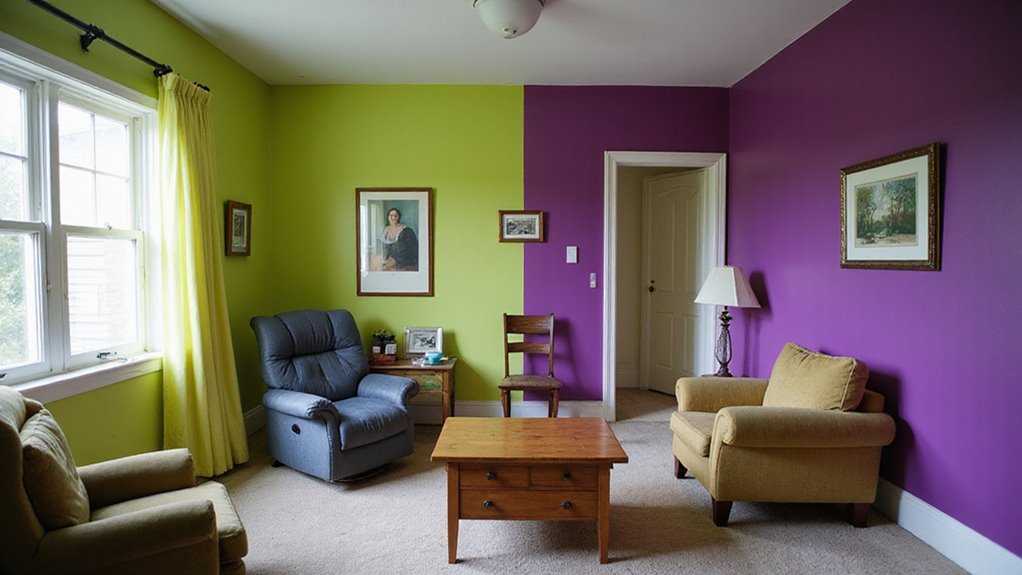
Avoid bold or polarizing colors that can turn off potential buyers, like bright reds or neon shades. Dark colors can make small spaces feel cramped and uninviting, so steer clear of deep blacks or moody hues.
Also, skip outdated trending colors, such as outdated greens or pastels, which may make your home seem less contemporary.
Bold and Polarizing Color Choices
Bold, polarizing colors hurt home value and deter potential buyers. Extreme color choices create negative first impressions and limit your pool of interested buyers.
Popular buyer-deterring colors include bright reds, neons, and unconventional shades like lime green or hot pink.
Simple neutral tones attract more buyers and promote faster sales. Soft beiges, warm grays, and gentle earth tones help viewers envision themselves in the space. Moreover, these colors create a calm, welcoming atmosphere that appeals to most tastes.
Real estate experts recommend using no more than three coordinating neutral colors throughout the home. This approach maximizes buyer appeal and preserves resale value.
Dark Colors That Shrink Spaces
Dark colors can visually reduce room size by absorbing light. Navy blue, charcoal gray, and deep brown will make spaces feel up to 30% smaller than their actual dimensions.
Small rooms become especially claustrophobic with dark paint colors on walls. Beyond that, potential buyers often reject homes with dark-colored rooms during viewings.
Light neutrals like soft white, beige, and pale gray create an open, welcoming atmosphere. These brighter colors reflect natural light and help rooms appear more spacious.
Outdated Trending Colors
The most outdated trending paint colors are neon shades, pale pastels, deep moody tones, and bold unconventional hues. These colors quickly lose their appeal and negatively impact home value. Popular but outdated options include bright yellow, mint green, burgundy, and eggplant purple.
Smart homeowners choose timeless neutral shades instead. White, beige, warm gray, and soft cream maintain their appeal across design trends.
Moreover, these classic colors create versatile spaces that attract more potential buyers. Rather than following temporary trends, select paint colors with lasting style and broad market appeal.
Regional Color Preferences to Consider
Regional color preferences vary significantly across different areas of the United States. In Texas, neutral earth tones and warm colors connect best with local buyers. Beige, warm gray, and soft browns create an inviting atmosphere that matches the regional aesthetic.
Light, natural colors make spaces feel larger and more welcoming to prospective buyers. Popular choices include Sherwin-Williams Accessible Beige, Benjamin Moore Manchester Tan, and PPG’s Toasted Almond. These colors complement the Southwestern architecture and lifestyle.
Moreover, these color choices help maintain broad appeal during resale. Buyers can easily envision their furniture and decor in neutrally painted spaces.
How Much Does Interior Painting Increase Home Value?
Interior painting can significantly boost your home’s value, often providing a return of over 100% on the investment.
Well-chosen colors and finishes influence buyer perception, making your home more appealing and easier to sell.
Considering the costs and influential impact on buyer psychology helps you make smarter choices that maximize your return.
ROI of Interior Painting
Interior painting typically yields a 107-110% return on investment for residential properties. Proper paint jobs add immediate value while making homes more attractive to potential buyers.
Strategic color choices create the biggest impact on ROI. Neutral tones appeal to most buyers, while quality finishes ensure durability. The living room, kitchen, and bedrooms offer the highest returns.
To maximize value, professional painters recommend focusing on high-traffic areas. Light colors can increase perceived room size by up to 15%. Quality paint and expert application help ensure lasting results.
Cost vs. Value Analysis
Interior paint projects deliver strong financial returns compared to their costs. A quality paint job returns 107% of project costs on average during resale. Professional painting transforms dated spaces into fresh, appealing rooms that buyers value. Neutral colors like beige and gray create broad market appeal.
Smart paint choices in main living areas make the best impression on potential buyers. Light colors can increase perceived room size by up to 15%. Consider timeless colors instead of trendy options for lasting value.
The total investment remains modest relative to other home improvements. Professional interior painting averages $2-4 per square foot but can boost home value by $2,000-9,000.
Buyer Psychology and Perceived Value
Buyer psychology directly influences how people perceive a home’s value and make purchase decisions. Smart color choices tap into this psychology by creating positive first impressions. Neutral paint colors make spaces feel larger, cleaner, and more inviting.
Most buyers prefer neutral colors like beige, greige, and warm gray over bold or personalized choices. These colors can increase offers by 1-3% compared to bold colors. Fresh neutrals help buyers envision themselves in the space without distractions.
Moreover, market-friendly paint colors reduce time-to-sale and expand the potential buyer pool. Professional stagers consistently recommend neutral palettes to maximize appeal. These strategic color choices serve both sellers and buyers by creating universal appeal.
How to Prepare Your Home for Painting Before Selling?
Before painting, you need to clean and prepare surfaces to ensure a smooth, lasting finish. Decide whether to hire a professional or handle it yourself based on your skill and timeline.
Timing your project carefully and working around existing fixtures will help you achieve the best results and maximize your home’s appeal.
Surface Preparation Steps
Surface preparation requires four essential steps before painting begins. First, wash all walls completely to eliminate dust, grease, and dirt buildup. Next, sand any uneven areas and old paint to create a uniform surface.
Then, apply spackle or putty to repair holes and cracks in the walls. The final step involves securing painter’s tape around edges and trim for protection.
Proper surface prep leads to smoother paint application and better adhesion. Clean, even walls will showcase the new paint beautifully. Moreover, a well-prepared surface helps paint last significantly longer.
Professional vs. DIY Considerations
A professional painter costs more but delivers expert results in less time. A DIY approach saves money yet requires significant time and skill investment.
Professional painting services range from $2-6 per square foot, while DIY materials cost $200-500 for an average room.
Professionals bring specialized tools, proper insurance, and years of experience to each project. Their work often includes thorough prep, precise edging, and complete cleanup.
On the other hand, DIY painting lets homeowners maintain full control over timing and quality. Success depends on proper preparation, technique mastery, and careful attention to detail.
Timing Your Paint Job Strategically
Paint your home during mild weather, 2-3 months before listing it for sale. Fresh paint needs adequate time to cure and settle properly.
Complete interior painting at least 30 days before the first showing. This timeline prevents lingering paint odors and allows touch-ups if needed. A well-planned schedule helps avoid rushed work or mistakes.
Moreover, coordinate painting with other home improvements for efficiency. Smart scheduling prevents damage to new paint from renovation dust or debris. The right timing creates an inviting atmosphere that attracts potential buyers.
Working with Existing Features and Fixtures
Proper preparation of existing home features creates a foundation for successful painting. Clean and repair all surfaces before applying any paint.
A well-prepared surface requires sanding, patching, and priming to ensure professional results. The table outlines essential preparation steps for common household features.
Trim and baseboards need neutral colors, while cabinets can match or contrast with walls. Careful fixture protection prevents paint damage and costly replacements.
In addition, coordinated paint schemes enhance visual flow between rooms. Fresh paint on well-prepared surfaces increases home value and buyer appeal.
Light colors make spaces feel larger, while darker tones add drama to specific architectural elements.
Conclusion
Paint colors play a crucial role in selling your home quickly and for the best price. We at Next Step House Buyers understand how neutral colors create an inviting atmosphere. Our experience in Houston and Harris County shows that warm, welcoming tones attract more potential buyers.
When selling your home in areas like Tomball, Cypress, Conroe, Sugar Land, the right paint choices make a significant difference. We have helped numerous homeowners transform their spaces with strategic color selections. Our team knows which colors resonate best with local buyers in the Texas market.
At Next Step House Buyers, we’re committed to helping homeowners maximize their property’s appeal through smart improvements. We guide sellers through the entire process of preparing their homes for sale. Our expertise across Texas ensures you’ll receive the best advice for your specific market conditions.
